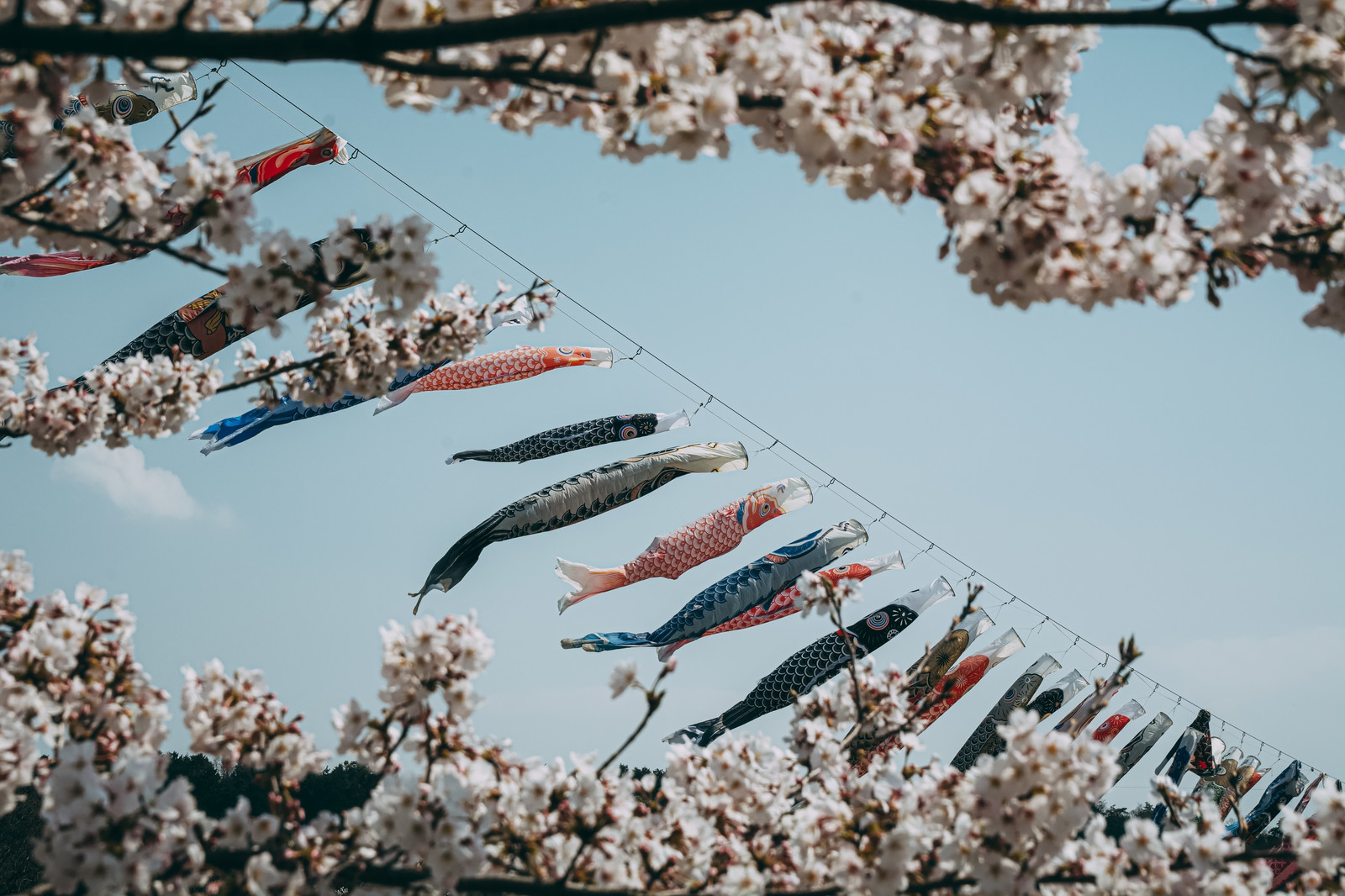5月5日は端午の節句、こどもの日です。
「こどもの日って何?」「日本ではどうやって祝うの?」と聞かれたとき、英語でスラスラ説明できるように、今回は、こどもの日の英語の説明の仕方をご紹介します。
英語記事:

「こどもの日」って英語で何と言う?
「こどもの日」は英語でChildren’s Dayといいます。
世界各国でこどもの日は祝われますが、祝われる日も、祝われ方も国によって違います。
日本のこどもの日を説明するときは、ただChildren’s Dayと訳すだけではなく、
もう少し詳しく説明してみましょう。
Children’s Day takes place on May 5th annually in Japan, hoping for a healthy growth of children as well as their happiness for the year.
こどもの日は子どもの健康と幸せを祈って、毎年5月5日に祝われます。
Children’s Day was officially established in 1948 as a national holiday.
こどもの日は、1948年に国民の祝日として制定されました。

「鯉のぼり」は英語で何と言う?
「鯉のぼり」は英語で、carp streamers と訳せますが、このままではあまり意味が通じませんので、そのまま「koinobori」と説明してもOKです。
Koinobori or carp streamers are carp-shaped windsocks displayed on Children’s Day in Japan.
鯉のぼりは、子どもの日に飾られる鯉の形をしたのぼりです。
Families will raise these carp-shaped windsocks to pray for perseverance and success of their children.
家族は子どもの忍耐強さと成功を祈って鯉の形をしたのぼりをあげます。
Koinobori have been considered as a symbol of power and toughness since the Edo period (1603-1868) when the custom originally started.
鯉のぼりは、この慣習が始まった江戸時代から、力強さと忍耐力の象徴とされてきました。
Carps are a symbol of strength, courage and success in the Japanese culture because of their ability to swim upstream.
上流をのぼっていくことから、鯉は日本文化の中で強さ、勇気、そして成功の象徴になっています。

Present day, the koinobori commonly consist of a big black koinobori for the father, next biggest red or pink koinobori for the mother, and additional, smaller carps of a different colors for each child, boys and girls.
現代では一般的に、父親の黒い鯉のぼりの次に、赤やピンクの母親の鯉のぼり、そして子どもを表す様々な色の鯉のぼりを飾ります。
「兜」や「五月人形」は英語で何と言う?
「兜」は traditional samurai helmet
「五月人形」は Japanese warrior dollsと言います。
On Children’s Day, a family would display traditional ornaments such as Kabuto (兜) and Gogatsu-ningyo (五月人形).
こどもの日には、兜や五月人形のような伝統的な飾りを飾ります。


Kabuto is a traditional samurai helmet often with the most beautiful decorations.
兜は美しい装飾品で飾られる、伝統的な侍の被り物です。
Gogatsu-ningyo refers to Japanese warrior dolls equipped with armor and Japanese sword.
五月人形は鎧や日本刀を纏った日本の侍の人形です。
People display them at home, hoping a healthy growth of boys.
男の子の健やかな成長を願って家に飾られます。
「柏餅」や「ちまき」は英語で何と言う?
Kashiwamochi and Chimaki are the traditional Japanese sweets for Children’s Day.
柏餅とちまきは子どもの日に食べられる伝統的な日本菓子です。
Kashiwamochi is a mochi sweet filled with red beans and wrapped in oak leaf.
柏餅は柏の葉で包まれたあんこ入りの餅菓子です。


Chimaki is a mochi wrapped in bamboo leaves.
ちまきは、竹の葉で包まれた餅です。
In the Kanto region, it is common to eat Kashiwamochi on Children’s Day, but in the Kansai region on the other hand, it’s more common to eat Chimaki rather than Kashiwamochi.
関東地方では、柏餅をこどもの日に食べることが一般的ですが、関西地方では柏餅よりちまきを食べる方が一般的です。
英語で折り紙の兜の作り方を教えてみよう
実際に兜や鯉のぼりを用意することが難しい場合は、折り紙の兜の作り方を教えてあげると、喜ばれるかもしれません。
英語で兜の折り方を説明してみましょう。

- Fold the paper diagonally.
Take the bottom corner and fold it up to the top – like a triangle. Make sure that all the corners and edges are perfectly neat.
折り紙を対角線で折る
下端を上まで持ってきて三角のような形に折る
すべての角やふちが綺麗に合っているかを確認してください - Take both sides and fold them up to the top.
Take both of the bottom corners and fold them up to the top point. Make sure that the corners don’t overlap each other!
両端を上まで折る
下の両端を先端まで折り上げる
この時角が互いに重ならないようにしましょう! - Fold the top points down to the bottom points.
先端を下まで折る - Rotate the whole paper (turn the paper 180°).
折り紙を180度回転させる - Make two horns (two horns out to opposite directions).
Take the two top points and fold them outside
2つの角を作る(反対方向に向くように)
両側の先端を、外側に向けて折る - Fold the bottom of the sheet up to the middle & roll up the very bottom again.
折り紙の下の部分を真ん中あたりまで折り、最下部を再び折りあげる - Take the back sheet and push it inside the pocket!
紙の裏側を兜の中に入れ込む
こどもの日の祭やイベントを英語で案内
こどもの日に向けて、お祭やイベントが全国で開かれます。
鯉のぼりが空を泳いでいる様子を見ることができますので、紹介してみましょう。
You can see special collaboration at Tokyo Tower where 333 carp streamers fly around the symbolic tower of Tokyo. The number of carp represents the height of Tokyo Tower.
It also features a giant pacific saury called Sanma in Japanese. It is recognized as a symbol of hope and love for Ofunato city in Iwate prefecture which was affected by the earthquake in 2011.
東京タワーでは、東京タワーの高さと同じ、333の鯉のぼりが周りに飾られています。
また、鯉だけではなく巨大なサンマの鯉のぼりもあります。
2011年の東日本大震災で被災した岩手県の大船渡へ向けた、希望と愛の象徴となっています。

The koinobori event on the Asano River in Kanazawa is a bit different from the other carp streamer festivals. Instead of only having the streamers float in the wind, they also have streamers that are let down into the river for a little swim.
金沢の浅野川で行われる鯉のぼりイベントは、他の鯉のぼり祭とは少し違います。
風になびく鯉のぼりの代わりに、鯉のぼりを川に流しています。

ほかの国で「こどもの日」はどう祝われているの?
最後に、他の国の「こどもの日」はどのように祝われているのか見ていきましょう。
中国やロシアでは、6月1日に「国際こどもの日」を祝います。これは1925年に行われた子どもの福祉世界会議で定められました。
1954年に行われた国連会議では、11月20日を「世界こどもの日」としており、子どもたちの生活基準を改善し、世界的に子どもの権利を守るための日となっています。
とはいえ祝われ方も、祝われる日も世界各国様々です。
その中から少しだけご紹介します。
ナイジェリア・・・5月27日に祝われ、小中学校の子どもたちは休みになります。パレードに参加したり、お出かけしたり、大人がやるような仕事をやらせてもらえたり、パーティーを開催することもあるようです。
中国・・・6月1日に祝われ、キャンプに出かけたり、無料で映画が観られたり、14歳未満の子どもはこの日が休みになります。
ドイツ・・・冷戦中、東ドイツと西ドイツではこどもの日の祝われる日が異なり、今もその名残が残っているようです。東ドイツが6月1日に祝われていた一方、西ドイツでは9月20日に祝われていました。
東ドイツでは、こどもの日にプレゼントを贈ったり、特別な行事を開いたり、校外学習に出かける学校もあります。東西ドイツ統一の際、西ドイツのこどもの日がドイツ全体で採用されましたが、東ドイツ地域では、それがあまり浸透しなかったようです。
英語で説明しようシリーズ
▽子どもの日とあわせて、”Girl’s Day” ひな祭りを英語説明してみましょう!







コメント